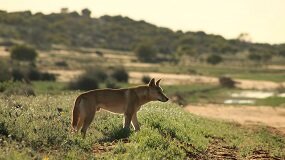Last updated May 11, 2017 at 3:27 pm
A study either side of the Dingo Fence has revealed that the environment suffers when you get rid of the native dog.
Research published in Proceedings of the Royal Society B and conducted by a team from the University of New South Wales shows that excluding dingoes allows kangaroo numbers to explode which, in turn, depletes the quality of the soil in dingo-excluded areas.
 The dingo fence was erected over 100 years ago to keep dingoes out of eastern Australia. It runs for about 5600 kilometres across South Australia, New South Wales and Queensland. While dingoes are common west of the fence, they are rare on the eastern side due to intensive poisoning, trapping and shooting over many decades.
The dingo fence was erected over 100 years ago to keep dingoes out of eastern Australia. It runs for about 5600 kilometres across South Australia, New South Wales and Queensland. While dingoes are common west of the fence, they are rare on the eastern side due to intensive poisoning, trapping and shooting over many decades.
The researchers studied four sites over four years looking at a national park and a pastoral site on each side of the fence in the Strzelecki Desert.
They counted dingoes and kangaroos at night as well as collecting dingo scats to determine what they ate. They also measured levels of phosphorus, nitrogen and carbon in the soil.
Kangaroo numbers were high on the “inside” of the fence where dingoes were rare, with just one dingo and 3245 kangaroos spotted. “Outside” the fence they counted 85 dingoes and only eight kangaroos.
They also found that overgrazing by large numbers of kangaroos on the eastern side of the fence reduced the vegetation cover. This led to lower levels of phosphorus, nitrogen and carbon in the soil, compared with areas where dingoes were common and kangaroos were rare on the western side.
The researchers conclude that greater control of kangaroo numbers is needed across a third of the Australian continent where dingoes are rare, to reduce damage on ecosystems.
- Link to original research article: rspb.royalsocietypublishing.org/content/284/1854/20170111
Image credit (both): Charlotte Mills/UNSW
Did you like this blog? Follow us on Facebook, Twitter and Instagram to get all the latest science.





















